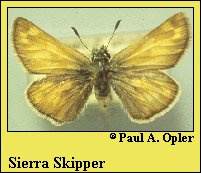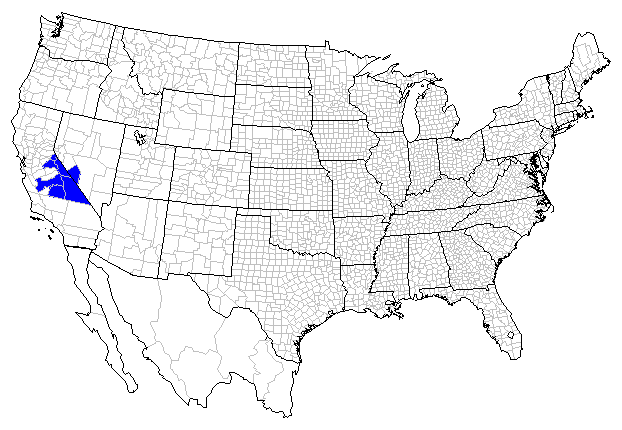 |
 

 |



Sierra Skipper (Hesperia miriamae MacNeill)
Wing span: 1 1/8 - 1 1/4 inches (2.9 - 3.2 cm).
Identification: Live individuals have a blue sheen above and below. Upperside is yellow-orange. Forewing has a diffuse dark border and large pale spots near the tip. Underside is gray with yellow-orange at the base of the forewing and large rectangular white spots on the hindwing.
Life history: To watch for receptive females, males perch on top of hills or ridges all day. Females lay eggs on the host grass. Caterpillars live in silken tubes at the base of grass clumps and feed on grass leaves nearby; then overwinter in partially-buried shelters.
Flight: One brood from July-August.
Caterpillar hosts: Perhaps alpine fescue (Festuca brachyphylla).
Adult food: Flower nectar.
Habitat: Rocky alpine tundra from 11,000-14,000 feet.
Range: The Sierra Nevada from Tuolumne County to Inyo County, California; White Mountains of eastern California and western Nevada.
Conservation: Populations should be monitored and threats, if any, identified.
The Nature Conservancy Global Rank: G2 - Imperiled globally because of rarity (6 to 20 occurrences), or because of other factors demonstrably making it very vulnerable to extinction throughout its range. (Endangered throughout its range).
Management needs:
References:
Scott, J. A. 1986. The butterflies of North America. Stanford University Press,
Stanford, Calif. 583 pages, 64 color plates.
Stanford, R. E. and P. A. Opler. 1993. Atlas of western USA butterflies including
adjacent parts of Canada and Mexico. Denver and Fort Collins, CO.
Tilden, J. W. 1986. A field guide to western butterflies. Houghton-Mifflin Co.,
Boston, Mass. 370 pages, 23 color plates.
Author: Jane M. Struttmann

